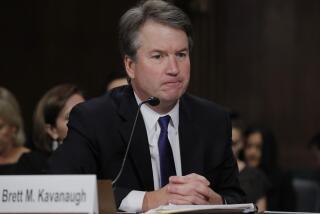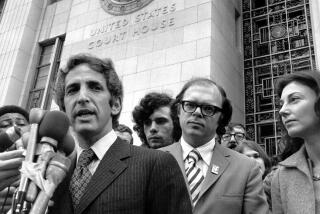How anthrax case stalled
WASHINGTON â The federal investigation into the deadly anthrax mailings of late 2001 was undermined by leaks and a premature fixation on a single suspect, according to investigators involved in the case.
More than six years after the mailings, no one has been charged, and the top suspect, former Army scientist Steven J. Hatfill, was all but exonerated Friday when the U.S. Justice Department agreed to pay him $5.82 million to settle a lawsuit.
The anthrax mailings killed five people, crippled mail delivery in some areas and closed a Senate office building for months, heightening anxiety on the heels of the Sept. 11 terrorist attacks. Now, dozens of interviews by the Los Angeles Times and a review of newly available testimony from Hatfillâs lawsuit reveal a flawed investigation marked by abnormal tactics and internal dissent.
Behind the scenes, FBI agents chafed at their supervisorsâ obsession with Hatfill, who in 2002 was publicly identified by then-Atty. Gen. John D. Ashcroft as âa person of interest.â The preoccupation with Hatfill persisted for years, long after investigators failed to turn up any evidence linking him to the mailings. Other potential suspects and leads were ignored or given insufficient attention, investigators said.
One official who criticized Ashcroft for singling out Hatfill was rebuked by the FBI directorâs top aide.
When Hatfill, now 54, landed a government-funded university job, the Department of Justice forced his dismissal. Ashcroft and FBI officials testified that they knew of no precedent for such intervention.
Investigators also questioned orders from their bosses to share confidential information with political leaders -- a departure from normal procedure. The security of information within the probe was so lax that FBI agents found news helicopters racing them to the scenes of searches. One exasperated agent called the leaks to the media âridiculous.â
When an official proposed using lie-detector tests to find the source of the leaks, FBI Director Robert S. Mueller III dismissed the idea, saying it would be âbad for morale,â according to testimony by one of the lead agents on the case.
The previously undisclosed testimony by agents and their supervisors is from depositions conducted by Hatfillâs lawyers. In his lawsuit, filed in 2003, Hatfill alleged that the FBI and Justice Department violated his privacy and damaged his reputation and prospects for employment.
According to its website, the FBI has âdevoted hundreds of thousands of agent-hours to the case,â conducted more than 9,100 interviews, obtained about 6,000 grand jury subpoenas and completed 67 searches.
A federal judge who reviewed details of the anthrax investigation, including still-secret FBI summaries, declared earlier this year: âThere is not a scintilla of evidence that would indicate that Dr. Hatfill had anything to do with this.â
FBI leaders had remained fixated on Hatfill into late 2006, agents said.
âThey exhausted a tremendous amount of time and energy on him,â said one of the FBI agents involved with the case who spoke to The Times on condition of anonymity because the investigation is continuing.
âIâm still convinced that whatever seemed interesting or worth pursuing was just basically nullified in the months or year following when âperson of interestâ came out about Hatfill,â he said. Other possibilities got short shrift, he said, because of assumptions within the FBI that âsooner or later theyâll have this guy nailed.â
Said another investigator: âParticular management people felt, âHe is the right guy. If we only put this amount of energy into him, weâll get to the end of the rainbow.â Did it take energy away? It had to have. Because you canât pull up another hundred agents and say, âYou go work these leads [that] these guys canât because theyâre just focused on Hatfill.â â
Mueller testified in a deposition that the probe posed tall obstacles. With no obvious suspect initially, he said, the FBI had to conduct âpreliminary initial investigationsâ of a âuniverse of individualsâ with access to the strain of anthrax used in the attacks. He said he had told aides âto take what steps were necessary to prevent leaks,â which he believed had âundercutâ the investigation.
An FBI spokesman, Michael P. Kortan, said Mueller would not comment for this article. The spokesman added that âsolving this case is a top priority for the FBI. Our commitment is undiminished.â
A plume of powder
On Oct. 15., 2001, Mueller assigned the anthrax investigation to Van Harp, a 32-year veteran of the FBI. That morning, an aide to the U.S. Senate majority leader, Thomas Daschle (D-S.D.), opened an envelope on Capitol Hill, releasing a plume of powdery material. A photo editor in Florida had died mysteriously from anthrax 10 days earlier.
Harp learned that this investigation would not follow FBI procedures for strict confidentiality. For starters, Mueller instructed him to brief Daschle and Sen. Patrick Leahy (D-Vt.), chairman of the Judiciary Committee. Each had been intended recipients of anthrax letters.
FBI officials wanted to assure the senators that the bureau was âvery aggressively investigating the case,â Harp testified. Nevertheless, sharing confidential investigative information was, he said, âan unusual step.â
By the end of October, two Washington-area postal employees had died. In New York, a hospital supply worker also succumbed. On Nov. 21, 2001, the fifth anthrax victim, a woman in Oxford, Conn., died.
Federal investigators began looking into scientists who had worked with biological agents. Hatfill was one of those contacted for an FBI interview. His name also was floated within the gossipy networks of the scientific community. Some academics speculated that the mailings were the work of an American who sent the anthrax to boost research funding.
The FBI organized three teams of specialists, based in Washington, D.C., and in Frederick, Md., near where Hatfill lived and worked. Other agents and postal inspectors were deployed in Florida, New Jersey and elsewhere.
But external pressures were outpacing the investigation.
On Jan. 4, 2002, New York Times columnist Nicholas D. Kristof began goading the FBI. âI think I know who sent out the anthrax last fall,â he wrote, describing the unnamed suspect as âan American insider, a man working in the military bio-weapons field.â
On May 24, Kristof called for lighting âa fire under the FBIâ and described the suspected American insider in more detail. Later, the columnist wrote that he was referring to Hatfill.
Hatfillâs background invited questions.
Raised in central Illinois, he attended college in Kansas before serving in the Army. He earned a medical degree at the University of Zimbabwe and practiced medicine in South Africa. From 1997 to 1999, Hatfill was a virology researcher in the Armyâs labs at Ft. Detrick, Md., specializing in ways to prevent or treat infection from such lethal pathogens as the Ebola and Marburg viruses.
In a search of Hatfillâs apartment, investigators found an unpublished novel he had written in which a wheelchair-bound man attacks Congress using plague bacteria.
Yet no physical evidence or witness account emerged to show that Hatfill had ever handled or possessed anthrax or that he had a role in mailing it.
Frustration at the FBIâs lack of progress festered among senators and their staffs, who privately questioned the bureauâs scientific competency and sense of urgency. The nine-story Hart Senate Office Building -- the Capitol Hill address of 50 senators and hundreds of staffers -- remained closed because of anthrax contamination.
FBI case agent Robert Roth testified that he found Daschleâs staff âhostile.â An aide to Leahy peppered the FBI with faxed questions about details of the case.
Meanwhile, Roth and veteran agent Bradley Garrett reached out to Hatfill repeatedly from December 2001 through spring 2002. Hatfill was cooperative throughout, they testified. He told the investigators he would welcome a search of his apartment.
But as Hatfill was signing a search authorization on June 25, 2002, at the FBI office in downtown Frederick, Roth spotted a media helicopter heading âright toward Steveâs house.â Within minutes after Hatfill had signed, droves of Washington- and Baltimore-based camera crews and reporters descended on his apartment.
âHow many people knew in advance that you intended to go to talk to Dr. Hatfill and try to get a consent to search?â asked Hatfillâs lawyer, Thomas G. Connolly, during a deposition.
âIt was probably several hundred,â Roth replied, including the mayor of Frederick.
Said Garrett: âI wouldnât have spoken to us after that event.â
Admired investigator
Garrett, then 53, was among the FBIâs most revered investigators. In 1997, he traveled to Pakistan to help apprehend a gunman who had killed two CIA workers outside agency headquarters in Langley, Va. He also obtained a confession from Ramzi Yousef, mastermind of the 1993 bombing of the World Trade Center.
Asked by Hatfillâs lawyer if it was âappropriateâ to disclose a planned search of a residence, Garrett replied:
âAbsolutely not.â
In addition to the risk of âforewarning people you are coming to search,â Garrett testified, âitâs clearly not appropriate or even responsible to do that in reference to the person you are searching. Heâs not been charged. He has not gone to court.â
Garrett added, âLetâs just say for the sake of argument that Dr. Hatfill did have something to do with the anthrax case, but he had three other people working with him to do it. You donât want them to know you are searching his place because then that alters their behavior. They can destroy evidence.â
When the FBI searched Hatfillâs apartment a second time, on Aug. 1, 2002, the media helicopters and the van loads of camera crews were there again.
âObviously, someone told them we were going to do that search,â Garrett testified.
Roth, who was with Garrett for both searches, said the tip-offs were âjust ridiculous.â
At one point, Roth and other FBI officials tried to trace who was accessing the central computer file in which all investigative interviews and other developments were stored. Roth said the file was âan open book,â used by âa huge group of people.â
Someone had leaked the information that the second search of Hatfillâs apartment was made with the authority of a court-issued warrant, which wrongly implied that Hatfill was no longer cooperating.
Mueller resisted when an official recommended a criminal probe of the leaks, with mandatory lie-detector tests for the anthrax investigators, Roth testified. The FBI director, Roth said, raised a hand and said, âI donât want to do that. . . . Itâs bad for morale to go after these people.â
Mueller testified that he did not recall the episode. He said he had backed at least one other leak investigation but did not know if any action was taken.
No charge, but a label
On Aug. 6, 2002, five days after the second, widely televised, search of Hatfillâs apartment, Ashcroft appeared on two network morning programs. On CBSâ âThe Early Show,â the attorney general was asked, âIs Dr. Hatfill a suspect?â
Ashcroft replied, âWell, heâs a person of interest.â
Hatfill had not been charged with a crime. But he had a label -- a label that officials used repeatedly. Ashcroft later testified that he did not think it âwould cause [Hatfill] stigmatization.â
Others at the FBI were concerned. Harp testified that he had viewed labeling Hatfill as âimproper.â Harp kept his misgivings private, but a newly assigned colleague spoke out.
Michael A. Mason, then the FBIâs executive assistant director, told reporters that, without sufficient evidence to charge someone with a crime, âthere is absolutely zero value to coming forward with names or definitions of persons of interest.â
Afterward, FBI Deputy Director Bruce J. Gebhardt privately rebuked Mason. Gebhardt said the remarks âdid not go over well in the front office,â according to testimony from another senior bureau official.
Despite the scrutiny, Hatfill landed a new job teaching public safety personnel how to respond to acts of terrorism. The $150,000-a-year position, at Louisiana State University, was funded by a grant from the Justice Department.
Arthur Eberhart, an FBI biohazards specialist who helped lead the anthrax investigation, testified that he saw a âconflictâ in Hatfill being paid to teach counter-terrorism while âhe was a suspect in the case.â Other officials also expressed qualms.
Soon after Hatfill began drawing his paycheck, a Justice Department grants administrator ordered the university to terminate his contract.
Ashcroft and five FBI officials testified that they knew of no other instance in which the government had forced an investigative target out of a nongovernmental job.
Still lacking any proof that he had committed a crime, the government put more pressure on Hatfill: Bloodhounds were brought in to seek any scent of anthrax in Hatfillâs apartment and places he frequented.
On Aug. 12, 2002, Newsweek magazine reported that the dogs âimmediately became agitated.â An unnamed law enforcement source was quoted, saying the bloodhounds âwent crazy.â
But FBI tests found no traces of anthrax, and investigators concluded that the dogsâ excitement was useless as evidence. Harp and Roscoe C. Howard Jr., then the U.S. attorney for Washington, D.C., acknowledged in testimony that they had confirmed details about the bloodhounds to Newsweek before the article was published.
In addition to the searches, a caravan of FBI agents photographed and videotaped Hatfill seven days a week for months. An FBI employee drove over Hatfillâs foot, prompting Washington, D.C., police to ticket him for âwalking to create a hazard.â
Media coverage of the 24-hour surveillance helped cement Hatfillâs public image as a central figure in the investigation. USA Today reported on May 29, 2003: âFBI officials believe they canât risk the embarrassment of losing track of Hatfill, even for a few hours, and then being confronted with more anthrax attacks.â
Away from public view, Hatfillâs lawyer had approached the FBI with an alternative: In exchange for ending the bumper-lock chase scenes, Hatfill would surrender his passport, agree to be outfitted with a satellite-guided tracking device and allow an FBI agent to remain with him at all times.
âThere were specific reasons that we did not accept that offer, but not because it was judged as insincere,â Roth said.
Probe gets new leader
As the first anniversary of the anthrax mailings passed with the case unsolved, Mueller phased out the soon-to-be-retired Harp by promoting a senior FBI agent from San Diego, Richard L. Lambert, to supervise the investigation.
Lambert also tended the concerns of congressional leaders. He and Mueller met privately with Daschle, Leahy and several Senate staffers. Leahy later told Vermont students in an online discussion that some of the briefings he received âhave been highly classified.â
According to Lambert, he and Mueller advised senators and staffers that the information was sensitive and confidential. But he also acknowledged that he erred by revealing Hatfillâs âstatus in this criminal investigation.â
âIt was inappropriate to discuss Steven Hatfill in the context of that meeting,â Lambert testified. âTypically, the FBI does not discuss the identity of any persons concerning an investigation. . . . We typically disclose our facts in a courtroom.â
Lambert described the labeling of Hatfill and the many leaks as potentially harmful to both Hatfill and to the investigation.
Nevertheless, for the next four years Lambert kept FBI and postal investigators focused on Hatfill, according to people familiar with the case.
Some dissatisfied agents sought a review of Lambert by the bureauâs Inspection Division, which evaluates FBI operations. âThere were complaints about him,â one agent told The Times. âDid he take energy away from looking at other people? The answer is yes.â
On Aug. 25, 2006, Mueller transferred Lambert off the case, naming him special agent in charge of the FBI field office in Knoxville, Tenn. Results of the Inspection Divisionâs review of the complaints have not been disclosed, and Lambert declined to be interviewed for this article.
The fixation on Hatfill ran broadly through FBI leadership. Eberhart, the biohazards expert, testified that when he retired in late 2002, âDr. Hatfill was our main focus.â
Now, many who have been involved with the anthrax case say they fear it will never be solved.
Said Peter Setlow, a University of Connecticut biochemist who has served as a consultant to the FBI:
âTheyâre not going to ever catch him until somebody confesses on their deathbed or something like that. Youâre not going to find a smoking gun.â
--
--
Times researcher Janet Lundblad in Los Angeles contributed to this report.
More to Read
Sign up for Essential California
The most important California stories and recommendations in your inbox every morning.
You may occasionally receive promotional content from the Los Angeles Times.











